
Hornet 'Mini Wings' 1/144 Super Mystere
| KIT #: | mini008 |
| PRICE: | $27.00 from www.nostalgicplastic.com includes free US shipping |
| DECALS: | Two options |
| REVIEWER: | Scott Van Aken |
| NOTES: | Resin kit with vac canopy. |

| HISTORY |
The Super Mystère represents the final step in evolution which began with theDassault Ouragan and progressed through theMystère II/III andMystère IV. While earlier Mystère variants could attain supersonic speeds only in a dive, the Super Mystère could exceed the speed of sound in level flight. This was achieved thanks to the new thin wing with 45° of sweep (compared with 41° of sweep in theMystère IV and only 33° inMystère II) and the use of anafterburner-equippedturbojet engine.
The first prototype Super Mystère B.1, powered by aRolls-Royce Avon RA.7R, took to the air on March 2, 1955. The aircraft broke the sound barrier in level flight the following day. The aircraft entered production in 1957 as the Super Mystère B.2. The production version differed from the prototype by having a more powerfulSNECMA Atar 101G engine. In 1958, two Super Mystère B.4 prototypes were built. Equipped with a new 48° swept wing and a more powerfulSNECMA Atar 9B engine, the aircraft were capable ofMach 1.4. Production never materialized because the fasterDassault Mirage III was entering service. In 1973, theIsraeli Air Force upgraded their Super Mystère B.2 with a non-afterburning version of thePratt & Whitney J52-P8A and new avionics.
A total of 180 Super Mystère B.2 were built.
| THE KIT |
 Part of a new line of kits in Hornet's "Mini Wings" series of 1/144 military aircraft, the Super Mystere B.2 kit comes in a sturdy cardboard box with the parts in a zip bag. This does not, unfortunately, keep the parts from being damaged in transit as several had detached themselves from the sprues and nose landing gear had broken. The damage will be easy to repair, but I'd rather have not had it happen in the first place. This is pretty well common stuff for most resin kits.
Part of a new line of kits in Hornet's "Mini Wings" series of 1/144 military aircraft, the Super Mystere B.2 kit comes in a sturdy cardboard box with the parts in a zip bag. This does not, unfortunately, keep the parts from being damaged in transit as several had detached themselves from the sprues and nose landing gear had broken. The damage will be easy to repair, but I'd rather have not had it happen in the first place. This is pretty well common stuff for most resin kits.
The kit is designed very much like a standard plastic kit. There are two fuselage halves with a separate intake and exhaust section. No intake trunking is provided, but it appears that the one piece cockpit/nose well piece will take care of that. Finding room for nose weight will be a bit of a challenge if one doesn't want to see it through the intake.
The kit has single piece flight surfaces, and that includes the fin/rudder. Also one piece moldings are the drop tanks, bombs and missiles, though I think that the Mystere would carry either bombs or missiles and not both. The cockpit has but a seat to help fill the space, however, in this scale, it doesn't really matter as little will be seen once it is installed. Two vacuform canopies are provided.
Instructions consist of a small, folded sheet that have an exploded view on one side and color decal placement/camouflage on the other. Generic color information is supplied for the exterior with none for the interior, gear legs, or wheel wells. I believe that black will work OK for the interior and seat while the wells and struts were probably left in bare metal. The two markings schemes include the box art scheme for a EC 1/5 aircraft in unpainted metal with black anti-glare and gun panels. This one has the tri-color rudder flash and red fuselage stripe. The other is for a camouflaged plane from EC 1/12 in what appears to be a US South East Asia scheme. However, looking at color photos of these planes, that scheme is only close.  Apparently the French used slightly different colors as the underside is shown as a blue grey vice a light grey as used by USAF planes in this scheme.
Apparently the French used slightly different colors as the underside is shown as a blue grey vice a light grey as used by USAF planes in this scheme.
The decal sheet is printed in Japan by Y-craft and appears to be a solid carrier, requiring each individual marking to be carefully cut out and trimmed. The sheet is in register and while the yellow surround seems to nearly disappear against the blue backing of the sheet, only actual use will tell how opaque these colors are. It almost looks like an ALPS printed sheet as the blue in the rudder flash is crosshatched and the lines on the fuselage stripe are a bit on the jagged side, but one has to look close to see. The center blue in the roundels is darker than that on the rudder stripe and they should be the same shade.
| CONCLUSIONS |
All in all, this is a very welcome kit. I was hoping to get this one for review when I saw them first advertised on the Nostalgic Plastic web site. Though it may seem as if I am a bit critical of the kit, the truth is that this is better than most short run resin kits that I've reviewed over the years, and the series includes a number of interesting subjects. Stay tuned for this one and check out what's available at the link below.
| REFERENCES |
http://en.wikipedia.org Thanks to www.nostalgicplastic.com for the preview kit. You can get yours today by visiting the link to the left. If you would like your product reviewed fairly and fairly quickly, please contact the editor or see other details in the Note to Contributors.